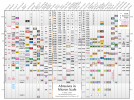A 1200 (EF) plated diamond hone (think of DMT's EF hone) can still leave a toothy bite in most steels. That has a lot to do with how much harder and deeper-cutting diamond is, relative to the steel's hardness. Diamond cuts much deeper at lighter pressure, relative to it's rated grit size, because it's nearly 10X as hard as hardened cutlery steel and nearly 3X as hard as the hardest of the carbides found in cutlery steels.
Once the relative hardness gap begins to narrow between the abrasive and the steel, even a coarse stone might not cut the steel as deeply and will therefore leave a finer finish than the stone's grit rating would imply. And a worn or glazed coarse stone might not cut it at all. This means it's effect on the steel will tend more towards burnishing/polishing, instead of cutting with aggressive metal removal. And very wear-resistant, carbide-rich steels will limit how much some stones can do. Trying to grind something like D2 on a natural stone, or sometimes even 440C, can be an exercise in frustration, no matter how coarse the natural stone might be. And the carbides in the steel will themselves polish ('glaze') the stone's grit, so the stone becomes even less aggressive as it's used.
Long story short, it depends on the steel, it's hardness and it's carbide content, vs the type of stone and abrasive doing the work.

